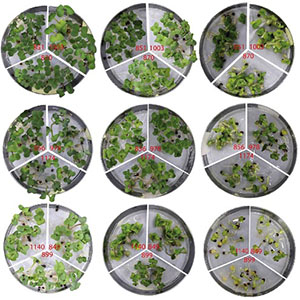Screening of salt tolerance traits and the salt tolerance evaluation method in Brassica napus at the seed germination stage

Accepted: 5 May 2022
Appendix: 46
Table S2: 96
Table S3: 91
Table S4: 102
HTML: 59
All claims expressed in this article are solely those of the authors and do not necessarily represent those of their affiliated organizations, or those of the publisher, the editors and the reviewers. Any product that may be evaluated in this article or claim that may be made by its manufacturer is not guaranteed or endorsed by the publisher.
Soil salinity is one of the major abiotic stresses that negatively affect plant growth and agricultural productivity. For many crop species, the germination stage is one of the most sensitive stages to salinity stress. This study evaluated salt tolerance in 200 Brassica napus L. germplasms using hierarchical cluster analysis based on multiple morphological parameters, including germination rate, root length, fresh weight of root, shoot length, fresh weight of shoot, and total fresh weight. Membership function was used as a comprehensive index to select and evaluate salt tolerance of these germplasms, identifying 8 highly salt-tolerant germplasms, 40 salt-tolerant germplasms, 65 moderate salt-tolerant germplasms, 52 salt-sensitive germplasms, and 35 highly saltsensitive germplasms lines. The responses of rapeseed germplasm to salt stress indicate differences in morphological parameters. Furthermore, NaCl showed a positive effect on total fresh weight and biomass production of some germplasms at a concentration of 100 mmol L–1. Since the correlation value of salt tolerance with total fresh weight was highest under 200 mmol L–1 NaCl, it can be considered the most reliable parameter to evaluate salt tolerance. Therefore, the findings of this study can be applied as an effective and reliable method for mass screening and evaluation of Brassica napus germplasm at the germination stage for breeding salt-tolerant rapeseed genotypes.
Highlights
- The salinity tolerance of 200 varieties of B. napus germplasms was investigated.
- B. napus is more vulnerable to saline conditions during the germination and early reproductive stages than the vegetative and flowering periods.
- Based on hierarchical cluster analysis, there was a wide variability of salinity tolerance among rapeseed germplasm.
- Low concentration of sodium chloride had a positive effect on shoot and root growth, germination and total weight in some B. napus seedlings.
- Total fresh weight can be utilized as the most efficient index for mass screening of salt tolerance in B. napus germplasms at the germination stage.
How to Cite

This work is licensed under a Creative Commons Attribution-NonCommercial 4.0 International License.
PAGEPress has chosen to apply the Creative Commons Attribution NonCommercial 4.0 International License (CC BY-NC 4.0) to all manuscripts to be published.

 https://doi.org/10.4081/ija.2022.2011
https://doi.org/10.4081/ija.2022.2011







